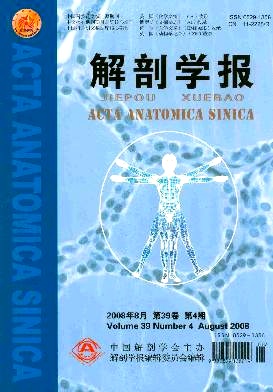|
|
THE DIFFERENTIATION OF HUMAN UMBILICAL CORD BLOOD CD34SUP>+/SUP> CELL INTO INSULINSECRETING CELLS INDUCED BY NICOTINAMIDE, BETACELLULIN, BFGF AND HGF
2007, 38 (2):
192-195.
doi:
Objective To investigate the differentiation of CD34SUP>+/SUP> cells derived from human umbilical cord blood into insulin secreating cells in an in vitro system supplemented with growth factors. Methods CD34+ cells were isolated by magnetic cell sorting(MACS). The purity of acquired cells was determined by FACS analysis. Purified CD34+ cells were cultured in DMEM supplemented with 5% FBS, 1×ITS, 10SUP>-4/SUP>mol/L ascorbic acid 2-phosphate, 4.7mg/L linoleic acid, and a combination of nicotinamide, betacellulin、bFGF and HGF. Cultured cells were collected on the 14th and 24th days after the induction to determine the extent of the cell conversion by microscopic observation on morphology, RT-PCR on the transcription of nestin, ngn3 and IPF-1 mRNA, immunocytochemistry on the expression of nestin and insulin, ELISA on the quantification of the insulin product in the medium. Results The isolation purity degree of CD34+ cells was greater than 90% after MACS. Nestin, ngn3 and IPF-1 mRNA were detected in the differentiated cells. Nestin and insulin positive cells were ovserved in the differentiated cells with immumocytochemical staining. The positive ratio of the differentiated cells were (9.8±2.7)%. Insulin ELISA result showed that the insulin product in the culture medium was significantly increased after induction in comparison with that in the control groups (P<0.01).Conclusion The differentiation of CD34+ cells derived from human umbilical cord blood into insulinsecreting cells may be induced by the growth factor mentioned aboveObjective To investigate the differentiation of CD34+ cells derived from human umbilical cord blood into insulin secreating cells in an in vitro system supplemented with growth factors. Methods CD34+ cells were isolated by magnetic cell sorting(MACS). The purity of acquired cells was determined by FACS analysis. Purified CD34+ cells were cultured in DMEM supplemented with 5% FBS, 1×ITS, 10SUP>-4/SUP>mol/L ascorbic acid 2-phosphate, 4.7mg/L linoleic acid, and a combination of nicotinamide, betacellulin、bFGF and HGF. Cultured cells were collected on the 14th and 24th days after the induction to determine the extent of the cell conversion by microscopic observation on morphology, RT-PCR on the transcription of nestin, ngn3 and IPF-1 mRNA, immunocytochemistry on the expression of nestin and insulin, ELISA on the quantification of the insulin product in the medium. Results The isolation purity degree of CD34+ cells was greater than 90% after MACS. Nestin, ngn3 and IPF-1 mRNA were detected in the differentiated cells. Nestin and insulin positive cells were ovserved in the differentiated cells with immumocytochemical staining. The positive ratio of the differentiated cells were (9.8±2.7)%. Insulin ELISA result showed that the insulin product in the culture medium was significantly increased after induction in comparison with that in the control groups (P<0.01).Conclusion The differentiation of CD34+ cells derived from human umbi
Related Articles |
Metrics
|


